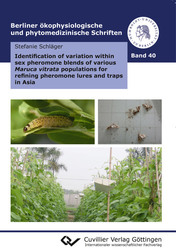| Fachbereiche | |
|---|---|
| Buchreihen (96) |
1378
|
| Nachhaltigkeit |
3
|
| Gesundheitswesen |
1
|
| Geisteswissenschaften |
2364
|
| Naturwissenschaften |
5406
|
| Mathematik | 229 |
| Informatik | 319 |
| Physik | 980 |
| Chemie | 1363 |
| Geowissenschaften | 131 |
| Humanmedizin | 243 |
| Zahn-, Mund- und Kieferheilkunde | 10 |
| Veterinärmedizin | 108 |
| Pharmazie | 147 |
| Biologie | 835 |
| Biochemie, Molekularbiologie, Gentechnologie | 121 |
| Biophysik | 25 |
| Ernährungs- und Haushaltswissenschaften | 45 |
| Land- und Agrarwissenschaften | 1004 |
| Forstwissenschaften | 201 |
| Gartenbauwissenschaft | 20 |
| Umweltforschung, Ökologie und Landespflege | 148 |
| Ingenieurwissenschaften |
1793
|
| Allgemein |
98
|
|
Leitlinien Unfallchirurgie
5. Auflage bestellen |
|
Erweiterte Suche
Identification of variation within sex pheromone blends of various Maruca vitrata populations for refining pheromone lures and traps in Asia (Band 40)
Stefanie Schläger (Autor)Vorschau
Inhaltsverzeichnis, PDF (79 KB)
Leseprobe, PDF (190 KB)
The legume pod borer, Maruca vitrata, causes severe damage on legume crops in the tropics. The larvae are mainly controlled by synthetic insecticides but without satisfying results. Monitoring of the moths using pheromone traps can help to perform target-oriented control measures. The objective of this study was the improvement of pheromone traps for monitoring M. vitrata in tropical Asia, where synthetic pheromone lures failed to attract males so far. In addition, the sexual communication system of different M. vitrata populations was investigated, since variation in pheromone composition is a potential reason for failure of pheromone lures.
| ISBN-13 (Printausgabe) | 9783736995703 |
| ISBN-13 (E-Book) | 9783736985704 |
| Buchendformat | A5 |
| Sprache | Englisch |
| Seitenanzahl | 104 |
| Umschlagkaschierung | matt |
| Auflage | 1. |
| Buchreihe | Berliner ökophysiologische und phytomedizinische Schriften |
| Band | 40 |
| Erscheinungsort | Göttingen |
| Promotionsort | Humboldt-Universität Berlin |
| Erscheinungsdatum | 12.07.2017 |
| Allgemeine Einordnung | Dissertation |
| Fachbereiche |
Land- und Agrarwissenschaften
Pflanzenproduktion |
| Schlagwörter | Maruca vitrata, crambidae, Sex pheromone, Pheromone traps, Pest monitoring |








